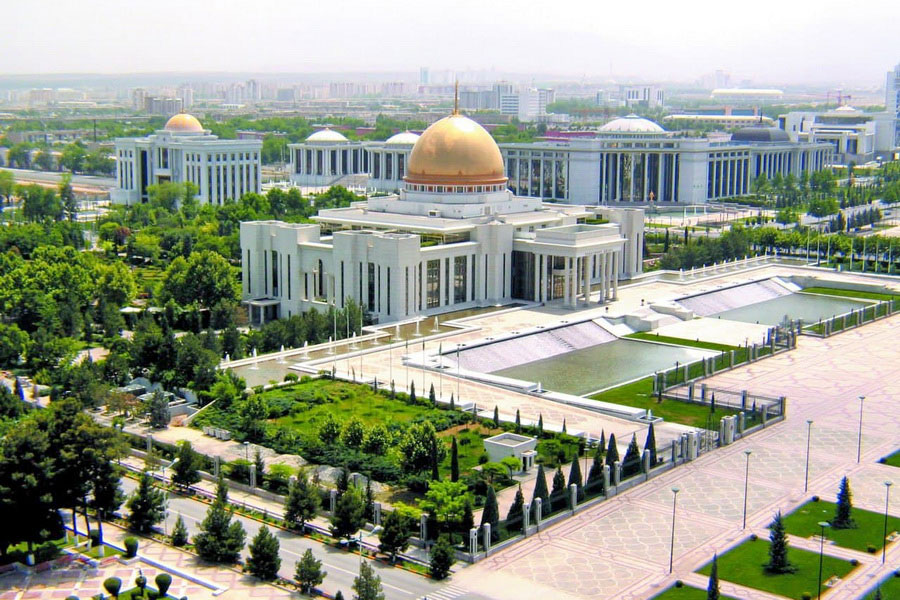
Official name: Turkmenistan
Location: Turkmenistan is located in Central Asia; in the west it is washed by the Caspian Sea. Turkmenistan borders with Kazakhstan, Uzbekistan, Afghanistan and Iran on land, as well as with Russia and Azerbaijan in the sea. It has no access to the world ocean. There are mainly plains; almost 80% of the land territory is covered with Kara-Kum sands, one of the largest deserts in the world. Kopetdag Mountains, lying in the south of the country, are the natural border between Turkmenistan and Iran.
Capital: Ashgabat Read more...
Area:
Total: 491 200 sq km
Percentage of water surface: 4,9%
Land borders: 3736 km
744 km with Afghanistan, 992 km with Iran, 379 km with Kazakhstan, 1621 km with Uzbekistan Read more...
Population: 5,663 millions (as of 2016)
Ashgabat: 1,003 678
Balkanabat: 89,785
Dashoguz: 227,184
Mary: 208,682
Turkmenabat: 408,906 Read more...
Language: Turkmen is the official language. It belongs to the Turkic group of languages. Apart from Turkmenistan, native speakers of this language can also be found in Iran, Turkey, Afghanistan, Uzbekistan, Kazakhstan and Russia (Stavropol region). Turkmen alphabet is based on Latin and consists of 30 letters; there are also many words borrowed from Russian. There are over 30 dialects that correspond to ethnical Turkmen groups: Teke (central part of Turkmenistan), Jomud (western and northern regions), Ersarin (eastern regions, along Amu-Darya), Salyr (Serakhs region on the border with Iran), Saryk (middle current of Murghab), Chodur (Tashauz) and others. Dialect of Stavropol Turkmens is traditionally called Trukhmen language.
Religion: prevalent religion in Turkmenistan is Islam; up to 89% of the population are Muslims, mainly confessing Sunni branch of Islam. Christians are around 9% of the population; other confessions are shared by 2% of the population.
The state guarantees freedom of religions and conscience, and equality before law. Religious organizations are separate from the state, cannot interfere the state affairs and carry out state functions. The public education system is separate from religious organizations. Read more...
Political system: Unitary republic. President is the head of state.
Legislature: Mejlis (unicameral parliament)
Administrative-territorial division: Turkmenistan consists of vilayats (Ahal, Balkan, Dashoguz, Lebap, Mary), etraps, gengeshliks and populated areas of five administrative categories.
National currency: National monetary unit of Turkmenistan is “manat”; 1 manat = 100 tenge. It was introduced on 1 November, 1993. Banknote denominations are in 1, 5, 10, 20, 50 and 100 manats; coins are in 1, 2, 5, 10, 20 and 50 tenge. Read more...
Flag of Turkmenistan: Flag of Turkmenistan features a rectangular green field with a vertical red stripe where five carpet patterns (gul, symbolizing five regions of the country) are lined up. There are olive branches under guls symbolizing the status of permanent neutrality of Turkmenistan. To the right of the stripe, a crescent and 5 five-pointed white stars are featured. Read more...
Emblem of Turkmenistan: Emblem of Turkmenistan is an eight-point green starburst with golden edges featuring two circles. Main elements of national richness and symbol of the state are featured on the green background of the eight-point red circle:
- In the lower part, you will see white cotton with green leaves;
- In the middle part – sheaves of wheat;
- In the upper part – crescent with five pointed stars.
The round stripe of the red disc features five main carpet guls: Akhalteke, Salyr, Ersary, Chodur, Jomud that symbolize friendship and unity of Turkmen nation. The blue circle has Yanardag – Akhalteke horse of Turkmenbashi. Classic type of the unique Akhalteke breed is a source of pride for Turkmen people. Read more...
Largest cities: Ashgabat, Turkmenabat, Dashoguz, Balkanabat, Turkmenbashy, Mary.

